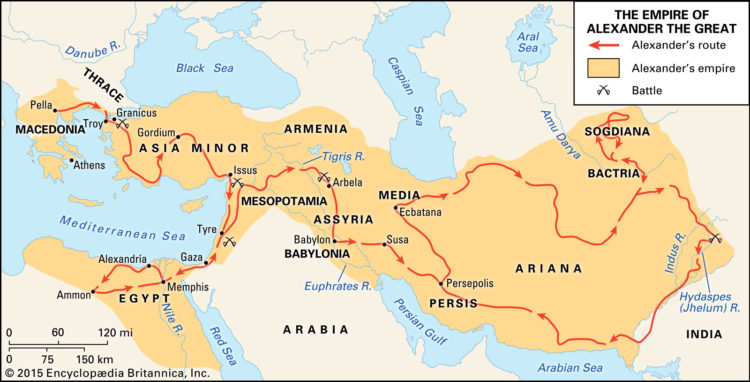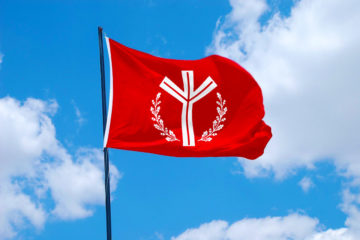WLP88 – William Pierce: The Historian
by Dr. William L. Pierce
A BIAS in favor of the Middle East as the “cradle of civilization” has been so strong for so long that it dies hard, even in the face of the rapidly mounting proof that many of the arts of civilization — although not cities themselves — had their origins in Europe rather than in the Middle East.
Part of this bias was originally religious in nature and stemmed from the veneration formerly attached to the Old Testament by Europeans. Jewish mythology, of course, locates the Garden of Eden, whence man and his culture supposedly spread over the earth, in the Middle East.
Also, the oldest cities quite clearly were in the Middle East — the ruins of Jericho, for example, date back some 9,000 years — and there was an understandable tendency to assume that a higher intellectual and cultural level existed in the teeming cities of the Middle East than in the scattered villages of Europe in the millennia following the close of the Ice Age. Thus arose the archaeological presumption, ex oriente lux (light from the east), which saw the Middle East as a brightly glowing center of cultural innovation, from which new inventions and ideas spread out like illuminating rays, eventually reaching even the most backward areas of Europe.
Whether the 9,000-year-old Azilian alphabet stones are meaningless daubings or man’s first writing can only be decided after a great deal more archaeological research into the Mesolithic period has been done. Uncovering Mesolithic artifacts in Europe is much more difficult than finding Neolithic artifacts in the Middle East, where population densities were 100 times greater. But what is already certain is that many cultural innovations which had formerly been attributed to the Middle East actually were European in origin. [Who We Are #5 — Europe’s Stone-Age Evolution]
* * *
Nordics were, above all else, warriors. Weapons were always the most prominent artifacts buried with them. Next to their weapons in their regard were their horses, and a dead warrior’s horse was often sacrificed and buried with him.
So, too, sometimes were their wives and their slaves. (The Hindu practice of suttee had its origin in the Nordic invasion of India 35 centuries ago.) Both slave sacrifice and the rich burials of some Nordics testify to a highly stratified or hierarchical social structure.
The most common symbolism on pottery, amber pendants, and other grave items was solar, confirming the fact that the Nordics were (and always have been) worshippers of the sun and the sky — more generally, of Nature, with an emphasis on its active, male, creative aspect, as epitomized by the life-giving sun. This contrasts sharply with the religious symbolism of the Neolithic society to the west, in Old Europe, with its Mediterranean racial basis; that symbolism was feminine, centered on the female-reproductive aspect of Nature.
The Nordics lived typically in small villages or settlements of only a few timbered houses, an arrangement suited to their need for relatively large amounts of open land for grazing. Though they were settled relatively sparsely in their homeland, the Nordics maintained a high degree of cultural uniformity over a rather large territory, a consequence of the high degree of mobility which their lifestyle conferred upon them.
They erupted into Old Europe in three major waves, beginning about 6,400 years ago and spanning 16 centuries.
The Nordics cut through Old Europe like a hot knife through warm butter. [Who We Are #7 — Ice Age Nordics]
* * *
It is, of course, a shame that we have not a trace left of the languages spoken by the Cro-Magnon hunters of the Ice Age, and only a few undecipherable scraps left of the languages spoken (and, perhaps, written) by the Mediterranean peoples of Old Europe. Those languages of our White cousins and ancestors are lost to us forever. But the Nordic conquerors of Europe, in those long-ago invasions, though they thoroughly obliterated the indigenous languages of Europe, gave us something immensely valuable in return in the form of linguistic unity over a vast area of the earth’s surface.
It is because of this that 99 per cent of the White people on earth today speak languages which are closely related to one another. The psyche of a race, which is genetically determined, in turn determines the broad outlines of the forms taken by the race’s cultural developments, including language. And the structure of a people’s language certainly plays a major role in that people’s approach to the world around them — ultimately, in their manner and degree of success in coping with the world.
English, Swedish, and German may sound quite different to the ear, but they are, in fact, very close to one another; their structures are the same; they have words for the same concepts; they are used by peoples whose manner of thinking is the same. And they differ radically from any non-Indo-European language, such as Chinese, Hebrew, or Xhosa. [Who We Are #7 — Ice Age Nordics]
* * *
Stonehenge, the celebrated megalithic temple and observatory in southern Britain, although it is exceptional in some ways, provides excellent insight into several aspects of life in northwestern Europe in the period following the first Indo-European arrival there…
The alignments of the trilithons and other stones in the structure prove conclusively that it was laid out precisely to facilitate the ritual observation of certain astronomical events: sunrise and sunset on the days of the summer and winter solstices and the vernal and autumnal equinoxes, and the northerly and southerly limits of the moon’s rather more complex pattern of rising and setting. There is also evidence that Stonehenge was used as a rather sophisticated astronomical computer to predict solar and lunar eclipses.
Until a few years ago most prehistorians took it for granted that the builders of Stonehenge — and of all other megalithic structures in western Europe — copied earlier megalithic models in the eastern Mediterranean….
Such an assumption followed naturally from the Judeo-Christian bias of the 19th century, a century which was still greatly under the influence of the Old Testament, with its Middle Eastern locale: all human culture originated in the Garden of Eden and spread out from there.
Even with the advent of radiocarbon dating in 1949, the notion of cultural diffusion from the Middle East was maintained by many. It was not until the calibration of radiocarbon dates against the absolute tree-ring calendar in the late 1960’s that the insidious tyranny of the ex oriente lux (light from the East) doctrine was finally overthrown. [Who We Are #8 — Megalithic Europeans]
* * *
[A] group of Indo-European invaders — part of a larger group given the name “Peoples of the Sea” by the Egyptians — landed on the coast of southern Canaan, conquered the local Semites, and established a kingdom. They were the Philistines, from whom came the modern name of the territory they occupied: Palestine…
The Philistines eventually extended their hegemony over the Semitic Israelites, who were their neighbors, and exacted tribute from the Israelite cities. The Israelites in turn regarded the Philistines as arch-enemies and hated them as only Jews can. Thus arose the Old Testament slurs against the Philistines, leading to the use of the word “Philistine” in a derogatory sense even today by Indo-Europeans raised on an unhealthy diet of Jewish mythology.
Every White man, woman, and child should understand that, on the contrary, the Philistines were the “good guys” in that ancient conflict between Aryan and Semite — a conflict which has continued unabated to this day. [Who We Are #11 — Indo-European Conquerors]
* * *
The ultimate downfall of the Nordic conquerors in Asia… can be traced to an economic consideration and to an error in human judgment. The economic consideration was that a conquered population, just like the land itself or the gold and other booty seized by the conquerors, had real value. Whether the people were enslaved or merely taxed as subjects, they were an economic resource which could be exploited by the conquerors. To drive them off the land or wipe them out completely would, from a strictly economic viewpoint, be akin to dumping captured gold into the ocean.
Such an action could be justified to a conquering tribe of Indo-Europeans only if they were willing to subordinate all economic considerations to the goal of maintaining their racial integrity into the indefinite future — and if they also had a sufficiently deep understanding of history to foresee the inevitability of racial mixing wherever two races are in close proximity. Unfortunately, even where the will for racial survival was very strong, the foresight was insufficient. Measures which were quite adequate to prevent racemixing for a few generations, or even for a few centuries, broke down over the course of a thousand years or more. [Who We Are #11 — Indo-European Conquerors]
* * *
The insidiousness of the destruction of a race through racemixing lies in the gradualness with which it can proceed. In the beginning one has two quite distinct races — one tall and fair, the other short and dark. Keeping the two from mixing genetically seems a simple matter.
The first step may be a simple matter of military indiscipline: the rape of a few hundred dasyu women in a rebellious district after a revolt is put down by Aryan warriors. Twenty years later there will be a crop of half-breeds in that district, and some of the half-breed females will be much lighter and comelier than the average dasyu.
These light ones will be especially likely to be targeted for rape the next time there is a rebellion — or the next time a gang of drunken Aryans goes out on the town. And so, 20 years later, there will be some quarter-breeds around — and some of these may be light enough to be chosen as concubines by the local Aryan landlord.
And so it goes, century after century, with the simple Black-White picture gradually giving way to one in which there is a continuous range of mongrels between the two racial extremes. Near the White end of the spectrum there will be some who, although carrying some dasyu genes, will be almost indistinguishable from the true Aryans. Drawing the line between what is Aryan and what is not becomes more and more difficult. And as the racial picture becomes more blurred, the will to preserve the race is sapped. Many of the almost-Aryans will be bright and energetic citizens; style will be mistaken for substance; the keen edge of the Aryan race-soul will be blunted by imperceptible degrees.
By the time the damage has become quite noticeable, racial decadence has become irreversible. The subtle but essential qualities of psyche and intellect in the Aryans which led to conquest and to the building of Aryan civilization are diluted to ineffectiveness in their almost-Aryan descendants 15 or 20 centuries later, even though fair hair and blue eyes may still be abundant.
That is what happened to Aryan Persia and Aryan India. And it is also what is happening to Aryan America and Aryan Europe today. [Who We Are #11 — Indo-European Conquerors]
* * *
The Macedonians in the fourth century B.C. still had the vigor which decadence had drained from the Greeks of the south, and Philip was able to establish Macedonian hegemony over the greater portion of the Balkan peninsula. In 338 B.C., in the battle of Chaeronea, he crushed the Greek armies, and Macedonia became a world power.
But it was Philip’s son, Alexander, who used this power base to launch a new and vastly greater wave of Nordic conquest. In 336, at the age of 20, he succeeded his father as king of Macedonia. Within a decade he had conquered most of the ancient world…
Unfortunately, despite his military and organizational genius, Alexander did not understand the racial basis of civilization. He dreamed of a unified world-empire, with all its diverse races expressing a single culture and ordered by a single rule…
And throughout his brief but uniquely dynamic career of empire-building, Alexander acted consistently with this dream. He adopted Asiatic customs and dress, blending them with the Macedonian lifestyle and requiring many of his officers to do the same. He left in power many of the native satraps of the conquered regions, after receiving their oaths of loyalty. And it was not Macedonian Pella, but Semitic Babylon which he chose as the capital of his empire…
On June 13, 323 B.C., at Babylon, Alexander, not yet 33 years ears old, died of a fever — and with him died the unnatural dream of a mixed-race universal empire. Most of his Macedonian troops at once repudiated their Asiatic wives. His satraps began revolting. The various plans he had set in motion for homogenizing the culture and government of his vast realm became sidetracked.
Elements of Alexander’s empire survived long after his death. In Egypt, for example, the Macedonian Ptolemaic dynasty lasted three centuries; Queen Cleopatra was not an Egyptian by blood, but a Macedonian. And in the east, after the breakup of the empire, local rulers claimed descent from Alexander, even as late as modern times.
But the far-flung empire itself had no natural unity, no unity of blood or spirit; and even if Alexander had lived long enough to impose an artificial unity of coinage and dress and language and custom, it would still have required the strength of his unique personality to hold it together. And it is well that the empire died with him; otherwise it might have sucked the best blood out of Europe for centuries, in a vain effort to maintain it. [Who We Are #12 — Nordic Latins]
* * *
Source: National Alliance







We miss you, Dr. Pierce. With steel in our hearts, and the inspiration you gave us in our souls, we move upward on the path you showed us.
The whole “Greeks were Nordic” thing would have been news to Aristotle, who repeatedly distinguished his people from the “fair northerners.” No disrespect to Dr. Pierce, but Aristotle was there. Dr. Pierce was not.
Aristotle “being there” doesn’t mean he was correct. Were the Greeks literate enough to record there history prior to their ethnogenesis in Greece, to retain any memory of their Steppe ancestors? Genetic science indicates that the Greeks had a strong paternal line of Steppe-ancestry. Greeks are broadly a mix of Steppe and Neolithic ancestry.
There is an Anthropologist, Robert Sepehr, that defies the school boy’s in the field. Robert on his well documented video’s on his website ‘Atlantean Gardens’ forever exposes the Aryans being the maker of ‘Ancient Civilization’ through agricultural & its animals, & the Horse & Wheel. He often exposes the Sanskrit being Indo European languages.